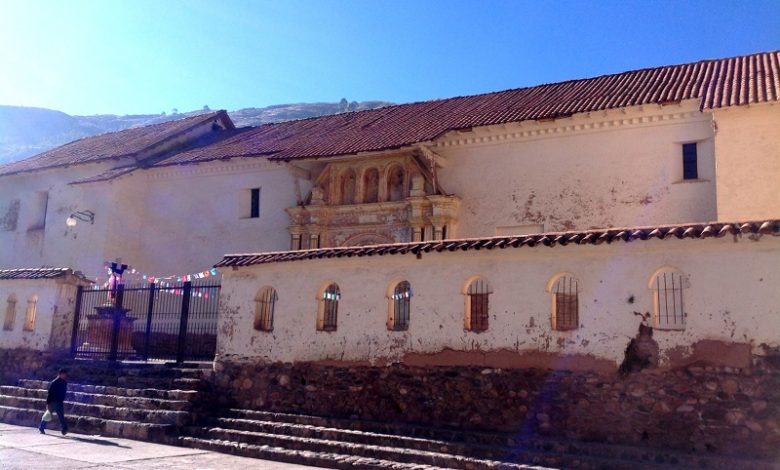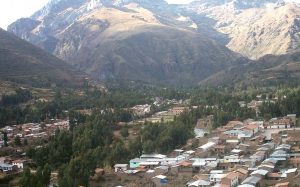Leaving this Life, an Octava in Pitumarka

In the Andes the octava is a ceremony that bids farewell to the deceased and reflects on their lives. The octava is a fusion of Native Andean and Catholic beliefs and takes place exactly eight
days after the funeral.
I am visiting Pitumarka again when we are approached by the family of a an important and recently deceased member of the community the former mayor of Pitumarka, Don Mariano Zavaleta. The Zavaleta family asks us to attend the octava for Don Mariano.
Years ago Don Timoteo served as registrar and learned the responsibilities of mayor-ship from Don Mariano. Pitumarkans tell me that Don Mariano was an good man who served his people honorably and that we should pay our respects. Unfortunately, Don Timoteo has a bad case of influenza and cannot attend.
It is 10 a.m. when we attend the service in the rarely open temple of Pitumarka. It was constructed in the late eighteenth century and is a native interpretation of Spanish Baroque architecture. The priest asks that certain items be brought to the service that were favored by the deceased. On an altar there is a picture of the former mayor surrounded by a basket of fruit, and a bottle of liquor the deceased can enjoy in the afterlife. There is a also a large basket of freshly baked bread on the floor at the base of the altar. I notice a perfect bunch of dark grapes carefully wrapped in paper in front of the deceased’s image. Sporting a new “North Face” fleece the priest finishes the ceremony by sprinkling holy water on the mourners surrounding the altar. As the procession leaves the temple, we are invited to the family compound to participate in the second part of the ceremony at the deceased’s former residence.

We cross the Pitumarka river into another suyo, one of four subdivisions or communities within the greater village of Pitumarka. Suyos represent the Andean cosmology which places and organizes Andean communities within time and place. Suyos are both complimentary oppositional entities providing both unity and tension within a community.

We approach a large but deteriorating walled compound. This residence is made up of mostly small, roofless adobe structures and a kitchen enclosing a large, grassy courtyard filled with chicken and sheep wandering about. We are led into a large salon with Spanish style stenciling along the deteriorating walls circling the ceiling. A newly installed roof protects the old walls from further damage. There are old bay windows with arched wooden frames along the wall opposite with a view of cornfields below. Benches are arranged along the walls and chairs are situated near a large cross-shaped altar reserved for the immediate family. Don Mariano’s widow, his children and grandchildren, who have come from all over Peru to pay their respects, are genuinely upset about his passing. Don Mariano was proud of his children and grandchildren most of whom became professionals.
Don Mariano’s picture and his mayoral identity card are placed above a large cross-shaped altar along with the offerings brought from the church. More offerings of selected pieces of fruit, all types of potatoes, a beautiful cake, bottles of cane liquor, expensive wine and beer were placed on the altar before we arrive. Other family members offer visitors seated around the salon small glasses of cane liquor, beer, and plates full of carefully prepared delicacies such as roast guinea pig and alpaca, mutton ribs and chuño (reconstituted freeze dried potatoes) topping a base of rice and noodles. All visitors and mourners greet each other, comfort one another and catch up on family news. Mourners accept food and drink while reflecting on the deceased’s life–some weep discreetly and conversations are held in whispers. Quechua is the language of intimacy and Spanish the language of formality. Candles flicker in the large salon adding to the solemnity of the occasion.
More offerings arrive wrapped in mantas (weavings) carried on the backs of friends, family, mourners and acquaintances. Offerings arrive all day and into the next morning and are reverently placed on the altar and on a larger manta placed on the floor.
Another altar is set up and each arrival of perfect potatoes and corn cobs necessitates the rearrangement of offerings into an ever larger mound on the ground. The offerings seem to describe the deceased’s life.
The immediate family sits closest to the altar. Nelida, Don Timoteo’s daughter, tells me that not so long ago, people sacrificed alpaca, llamas, guinea pigs and a favorite dog. They were brought to the altar in order to accompany the dead in the afterlife.
Nelida quietly leaves and quickly buys two bottles of highly coveted dark beer. When she returns, she quietly places them on the altar and takes her seat. Eventually, a family member conducts mourners in a prayer venerating the deceased’s life and a non-clergy specialist sprinkles holy water on the altar.
As the day progresses, mourners come and go. The family remains until the next morning and divide the offerings among family members. In the past, sacrificed animals were buried with the deceased. I remained with the impression that Don Mariano Zavaleta was celebrated as much for how people remembered him as much as how he lived his life.




